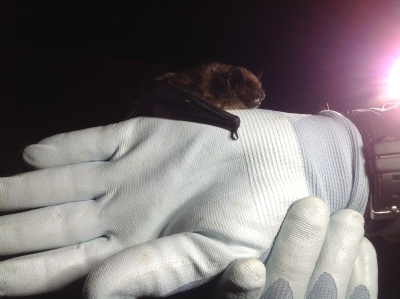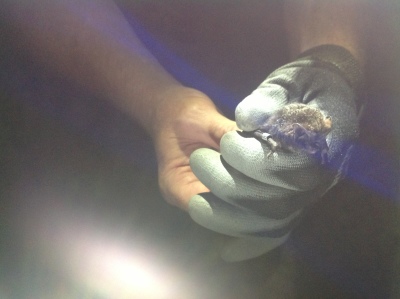THE PERFECT SWARM
Bat-catching on an English autumn night
There are many joys to mammal-watching, but one is undoubtedly a tendency to do peculiar things. Take visiting a cave on a September dusk and placing long nets outside it, and then waiting, chatting in the gloom in the hope that furry animals with wings will fly into the mesh. Take sitting down with bat in gloved hand, extracting measurements by torchlight, fiddling with calipers and fine spring scales, checking the bats’ teeth and private parts, in a manner suggesting that this is normal life. It isn’t normal, but it is classic mammal-watching. While the world sleeps, we have adventures.
I had wanted to experience bat “swarming” ever since I had heard of it the first time a few years ago. It is one of the least-understood aspects of British mammal behaviour. Every autumn, between August and October, certain bat species (mainly the Myotis species and Long-eared Bats) gather at the mouths of caves and tunnels and frolic about, with much chasing. It seems that swarming is related to breeding, finding a suitably unrelated mate or mates. Most of the bats concerned are sedentary for the rest of the year, but remarkably, they can travel 50km or more to a swarming site. Boy meets girl and the genes flow.
That’s the theory, but much is yet to be learned, which is why the Dorset Bat Group carries out regular catches at swarming sites each year. The sessions get filled up eagerly by bat-watchers and workers. Ours was in late September, and it was spectacular.
There was an unmistakable optimistic feel as we put up the four long nets. It was a warm evening and hardly a whisper of wind furled the mesh. Last month had been breezy, with just four bats caught in six hours – admittedly all of them Brandt’s Bats. In advance of proper darkness, a few of us made a short pilgrimage to watch the emergence of the local Greater Horseshoe Bats, flitting about the cave entrance, their ultrasonic calls making the bat detector giggle, and scarcely had we returned when the call went up that work was beginning. It was only 7.30pm, and already three bats had got themselves caught: a Brown Long-eared Bat and two Common Pipistrelles. As these bats were weighed, measured, sexed and marked by clipping the fur (so that we will know if and when they return), a Serotine flew high above us – bat heaven.
Pipistrelles, incidentally, are not supposed to swarm and neither, indeed, was our next capture fifteen minutes later, a fine Greater Horseshoe Bat. Perhaps these individuals were simply foraging around the cave entrance, or perhaps they were unaware of the research telling them that they have different mating arrangements. A few hours later we caught a Serotine, too, right inside the cave, away from where it should have been. That’s the beauty of field work, of course, setting more questions than providing answers.
Soon, though, the session settled down into classic swarming. Our first Natterer’s Bat was caught at 8.35pm, and signalled a veritable deluge of this species. First it was “another Natterer’s” and then we started making rude comments about them. Over the six hours we caught 40 Nat Bats, each with its smart white waistcoat front. And the chances are that most people living in Dorset have never even heard of Natterer’s Bat, and still fewer have ever seen one. Our second-commonest catch, by the way, was another typical swarming species: Brown Long-eared Bat, with 20 individuals.
Much as we all love Natterer’s Bats, enthusiasts cannot help hoping in their quiet moments that, among the usual captures, there is a sprinkling of rarity value at each swarming event. That’s why there was an audible gasp when our colleague Pete announced that he had “something different”. The bat-bag was solemnly passed to leader Nick and, with a flourish of ceremony, he unveiled a Bechstein’s Bat, a great rarity with an exotic middle-European name, and the third-longest ears of any British species. It turned out to be the first of five Bechstein’s that evening. There are about 1500 animals in total in Britain.
There were a couple of other “something different” announcements on our blessed night: for two Whiskered Bats (the quintessential micro-bat, rare in these parts) and for a Barbastelle, the latter a favourite among bat workers for looking like a furry flying goblin; it’s hard to be beautiful when your eats meet across your forehead. Several of our party had never seen a Barbastelle at all before; even experienced bat workers quiver with excitement at seeing these rarities.
In the end, our session nabbed 80 individual bats of eight species in all. That’s eighty reasons for doing something odd on a mild autumnal evening.



That is a spectacular opportunity! Swarming of bats can be frightening and exciting at the same time. That shot a bat on your hand is just great, haven’t had the opportunity to hold a live one yet. Keep up with the bat watching, and please continue to share your photos.
I bought the large bat pttrean for my mom, who has made a very feminine pastel bat with pink wings and a little fuzzy grey bat, but I agree with the other people, we would LOVE teeny tiny bats, this guy is so cute please put him in the next tiny collection!